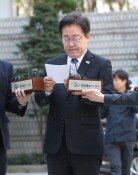Banjiha
Banjiha
Posted August. 11, 2022 08:00,
Updated August. 11, 2022 08:00
A family of three living in a semi-basement or a banjiha in Gwanak-gu, Seoul, was victimized by an unprecedentedly heavy rain that hard hit the capital area and the middle part of the country. Two sisters and a 13-year-old girl failed to get out of the semi-basement dwelling as rainwater flowed in an instant. Reportedly, one of the sisters had learning difficulties. A woman in her 50s also died in a semi-basement residence in Dongjak-gu, Seoul, amid the terrible flood.
Flood victims living in banjiha houses must have tried desperately to evacuate until the last minute. With water levels rising very quickly, they must have suffered from fear and pain while drowning to death. Neighbors of the family in Shinrim-dong, Gwanak-gu, rolled up their sleeves to get security window bars taken off, but to no avail. Heartbreakingly, those left in fear in the semi-basement with the door tightly blocked due to increasing water pressure must have been fearfully waiting for anyone to come to rescue them until they died.
Banjiha dwelling is a peculiar type of residence, which is hard to see in any other country than South Korea. With little light and fresh air inside, residents battle against musky odor, mold and pest in a dark and soggy space. This type of dwelling is unsafe and likely to be inundated by floods. Foreign media outlets use the original term ‘banjiha’ as a proper noun in articles on the country that took the brunt of a torrential downpour. A BBC reporter wrote that the disaster of the dead family is reminiscent of a heavy rain in the film ‘Parasite’ but described, “Only this outcome is far worse.”
As many as 327,320 households live in banjiha houses based on the data as of 2020, said the Statistics Korea. More than 60 percent of these residences are densely located in Dongjak-gu and Gwanak-gu, which often see flood damage, in the capital city notorious for sky-high housing prices. Those who struggle financially even to pay several million won in down payment for their house end up in a severely poor living environment. They are living proof of the dark shades of one of the most famous global cities dotted with lavish apartment buildings and skyscrapers.
Some action is supposed to be taken to get banjiha dwellers out of such a poor living environment where the minimum level of safety is never ensured. The growing trends of global warming will only aggravate disasters in terms of frequency and scale. The catastrophe that devastated the poor family in Gwanak-gu can repeat itself anytime anywhere.
The Seoul Metropolitan Government on Wednesday published measures to ban semi-basement units from being used for residential purposes, phase out the existing banjiha units and shift them into storages or parking lots. Land Minister Won Hee-ryong promised to set up plans to help those in need of decent dwellings. Their promises should never be just a lot of empty talk anymore. While accelerating their efforts to execute plans, authorities are supposed to come up with housing plans to supply rental houses to low-income families. No more tragedy must happen to take any life in a banjiha house in the 10th largest economic powerhouse in the world.







